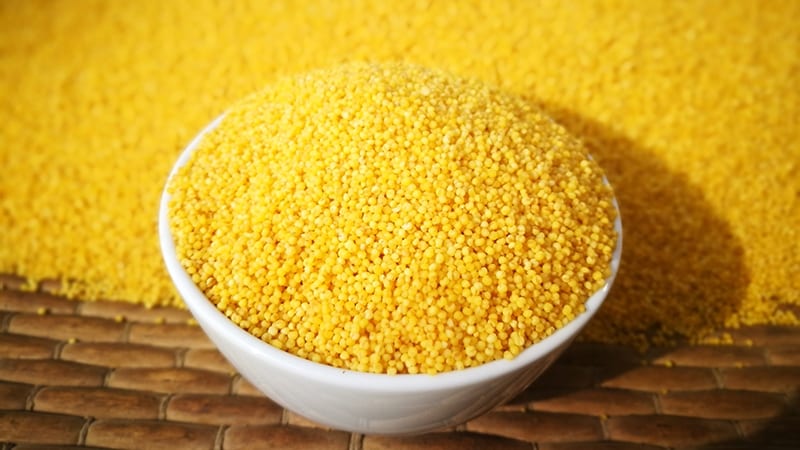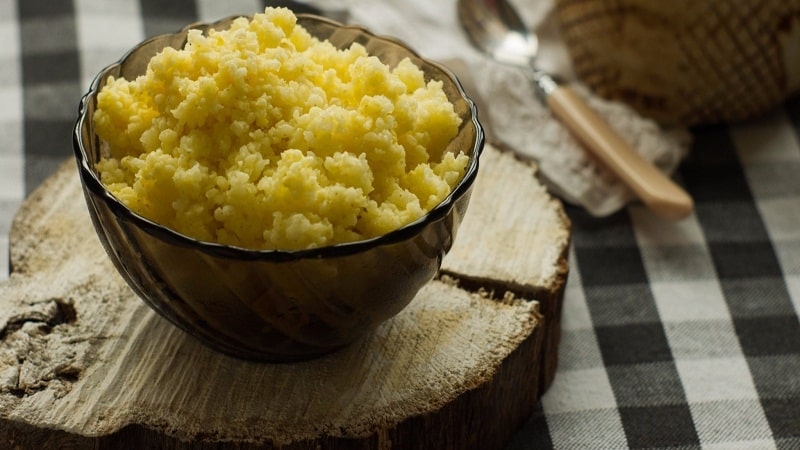What is millet, how does it grow and where is it used?
Millet is considered the most ancient cultivated grain on the planet. This plant has been beneficial to humans for many millennia, but not many people know what it looks like and what kind of cereal is obtained from it.
Photos, useful properties, uses of millet and much more interesting things are below.
What is millet
Millet is a valuable food crop, an annual cereal. Due to its drought resistance, it is cultivated in many areas of the world with unfavorable farming conditions.
More than 400 varieties of this cereal are known. Millet occurs naturally and as a wild herb.
What does the plant look like and what family does it belong to?
Millet has several varieties, similar in appearance to each other.
Capitate, or Italian, millet is grown as a forage crop. Ornamental millet has beautiful purple leaves and is used as a hedge. In mountainous areas, wild millet is a weedy grass.

Common millet (Panicum miliaseum) is of economic importance.
This is an annual herbaceous plant of the genus Millet, family Poaceae.
Millet has several stems that form a bush 0.45-1.5 m high. The stems are cylindrical, hollow inside, and have up to 10 nodes.
The leaves are linear-lanceolate in shape and arranged alternately. Size in length - from 18 to 65 cm, width - 1.5-4 cm. The color of the leaves is green with a reddish tint.
The fibrous, highly developed root penetrates the soil to a depth of more than 1.5 m and to the sides by 1-1.2 m.
Millet forms panicle inflorescences from 10 to 60 cm long, with 10-40 lateral branches.At the end of each branch there are single-flowered spikelets measuring 3-6 cm. The flowers are bisexual with hard, glossy scales that tightly cover the grain and fall off with it.
Depending on what kind of inflorescence the plant has, the following varieties of millet are distinguished:
- spreading with long straight panicles in which golden-yellow grains are formed;
- spreading with a long loose panicle;
- compressed forms long curved inflorescences;
- oval has a short, straight, medium loose panicle;
- lumpy with a short, straight, dense panicle.
Millet fruits are spherical grains up to 2 mm in size, colored white, yellow, red or brown. From these grains the cereal known as millet is obtained.
How and where it grows
Millet grains germinate at a temperature of 8-10ºС. The sprouts can withstand cold temperatures down to -2ºС. The plant tolerates temperature increases up to +40ºС. Millet does not require moisture; if there is a lack of water, it stops growing. Rainfall in the second half of summer is beneficial, unlike other cultivated cereals.
The first mentions of millet cultivation in ancient China and Transcaucasia date back to the 5th century BC. e.
India is considered the leader in cultivation. It accounts for more than 40% of total production. It is an important crop in China and African countries. In Russia, millet is grown in the arid regions of the Volga and Central Black Earth regions.
Chemical composition of cereals
Millet contains starch, proteins, fatty acids (oleic, palmitic, stearic and others), fiber, and essential amino acids.
Polished cereal is rich in vitamins B1, B2, PP, as well as beta-carotene.The product contains almost all the necessary microelements (iron, copper, iodine, silicon) and macroelements (calcium, magnesium, potassium, sulfur, phosphorus).
KBZHU
Contents per 100 g of dry cereal:
- protein - 11.2-11.5 g;
- fat - 3.3-3.9 g;
- carbohydrates - 54.6-66.5 g;
- energy value - 298-342 kcal.
The amount of nutrients varies depending on how the grain is processed.
Benefits and harms
When consuming millet, metabolism improves. The tone increases, the functioning of the nervous system is stabilized.
The high content of potassium and magnesium makes dishes based on millet cereals indispensable for maintaining cardiovascular health.
Iron accelerates hematopoietic processes, so millet is recommended for the prevention and treatment of anemia.
Millet does not contain gluten and can be safely consumed by people with allergic reactions to cereal proteins.
Millet has a low calorie content and at the same time gives a feeling of fullness for a long time. Therefore, dishes made from millet cereals are considered an ideal basis for dietary and fasting meals.
Millet should be consumed with caution by people prone to constipation. Dishes made from this cereal can be harmful if there is increased acidity of gastric juice, gastritis, or heartburn.
Attention! Millet dishes are not given to children under three years of age, because they are too heavy for an immature digestive system.
Types of cereals
There are three types of millet cereals, which differ in the method of production from raw materials:
- Dranets obtained by removing only the grain shells. With such gentle processing, most of the vitamins and minerals are preserved, which makes this type of cereal the most useful. The grains have a smooth, shiny surface. There is bitterness in the taste. Finding drapes on store shelves is not easy.
- Polished millet is more common, which is the kernel of millet grains. The shells and embryo are removed during the grinding process. The content of useful components is less than in shingles. The grain is smooth, matte, bright yellow.
- Crushed semolina consists of ground, polished millet. It boils quickly and is suitable for making viscous porridges.
- Polished grits have one unpleasant feature. When stored for a long time, the product acquires a bitter taste. This happens because the fats in the cereal oxidize when exposed to air—they go rancid. There is no need to stock this product in large quantities. When purchasing, choose clean, bright yellow beans without debris.


Application
Due to the high content of nutrients, minerals and vitamins, millet is widely used in various fields: cooking, cosmetology, folk medicine, and agriculture.
In cosmetology
Regular use of products with millet extract moisturizes the skin, makes it smooth and elastic, and reduces the appearance of age-related changes. Such creams and masks are suitable for caring for sensitive skin prone to allergic reactions.
B vitamins in the composition have a beneficial effect on metabolic processes in the follicles and scalp. Preparations based on millet extracts are used to strengthen the structure and stimulate hair growth.
In agriculture
Millet is included in feed for livestock and poultry. Not only grain is used here, but also husks and straw. Millet is often used in poultry farming; the cereal is useful for young animals.
Silage made from green mass is superior in nutritional value to barley and oat.
In folk medicine

There are many folk recipes based on millet and millet that help with diseases of the kidneys, liver, and cardiovascular system.
To reduce blood pressure, it is recommended to consume a total of 3 tbsp during the day. l. pre-washed and dried crushed grain. The product can be eaten dry or drunk as a decoction of the same volume of grains.
For pancreatitis, it is useful to eat a serving of millet porridge with pumpkin pulp and vegetable oil for dinner.
Millet is a known mild diuretic. The condition of kidney diseases is alleviated by infusion of grains in water. To prepare, take a glass of grains, pour 3 liters of hot water and leave for a day. Drink the product instead of other drinks.
In cooking
Millet cereal has a characteristic taste and smell that cannot be confused with any other.
Porridge is the most famous millet dish. It is boiled in water or milk, made sweet or lean, served with stewed vegetables and meat or dried fruits. It all depends on the taste preferences and imagination of the cook.
Crushed millet is used to prepare soups, most often vegetable soups, fish soup, and kharcho.
Millet makes casseroles with an interesting, unique taste.
How to cook millet porridge

Millet porridge is healthy, filling and tasty. A good housewife will always have 1-2 favorite recipes for this dish in her arsenal. For cooking, it is better to choose bright yellow cereals, without debris.
Below are several recipes that are good because they can be adjusted to suit your own taste and needs. For example, replace butter with vegetable oil or give up sugar.
On the water
Served as a separate dish or as a side dish.
For 4 servings:
- millet - 1 tbsp.;
- water - 2 tbsp;
- butter - 2-3 tbsp. l.;
- salt - 0.25-0.5 tsp. (taste);
- sugar - 1-3 tbsp. l. (taste).
The grains are sorted, thoroughly washed with water (5-7 times) and scalded with boiling water to get rid of bitterness. Place in boiling salted water, add 1 tbsp. l. oils Cook over low heat, stirring constantly, until thickened, 15-20 minutes. When serving, add the remaining melted butter and, if desired, sugar.
With milk
An ideal breakfast that gives you energy and a boost of good mood for the whole day.
For 4 servings:
- millet - 1 tbsp.;
- water - 2 tbsp;
- milk - 2 tbsp;
- butter - 2-3 tbsp. l. (taste);
- salt - 0.25-0.5 tsp. (taste);
- sugar - 1-3 tbsp. l. (taste).
The millet is washed until the water becomes clear and doused with boiling water. Add the prepared cereal to boiling salted water and cook over high heat until the water boils away. Meanwhile, milk is boiled.
When the water has evaporated, turn down the heat, add hot milk and cook, stirring, for about 10 minutes. Bring to readiness, leaving covered over very low heat for 5 minutes. Season the porridge with oil, add sugar or honey and dried fruits if desired.
With pumpkin
Can be prepared as a unique and healthy dessert.
For 4 servings:
- pumpkin - 1 kg;
- millet - 1 tbsp.;
- milk - 2 tbsp;
- butter - 2-3 tbsp. l. (taste);
- salt - 0.25-0.5 tsp. (taste);
- sugar - to taste.
pumpkin wash, peel, cut into small cubes (1×1 cm). The millet is washed well, poured with hot water for 5 minutes - this will remove the bitterness and the grain will cook faster. The milk is boiled (preferably in a thick-walled container).
The prepared pumpkin is placed in milk, salted, sugar is added and brought to a boil. Add the cereal, cook covered, stirring occasionally, over low heat until tender, 20-30 minutes. Serve with melted butter.
Read also:
How to pickle zucchini - 12 most delicious recipes.
Conclusion
Millet is a cereal of great economic importance. Due to its resistance to drought and heat, it is cultivated in many regions with an unfavorable climate for agriculture. The plant has a characteristic appearance for cereals: narrow, alternately arranged leaves, a hollow stem, and a fibrous root system. The peculiarity lies in the structure of the inflorescence. This is a panicle with spikelets at the ends of the branches. From the fruits - rounded grains - cereals are obtained, the well-known millet.
Millet porridge, for which every housewife has a favorite recipe, rightfully occupies a place of honor in Russian cuisine.
The high content of nutrients allows millet to be used not only in cooking, but also in cosmetology, folk medicine, and agriculture.